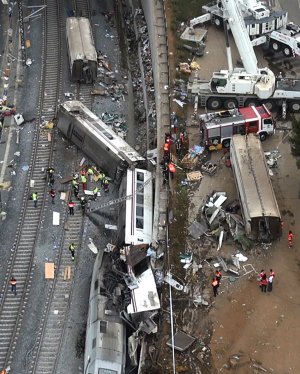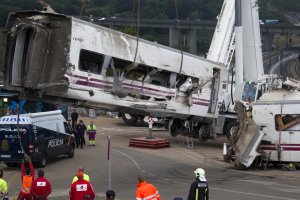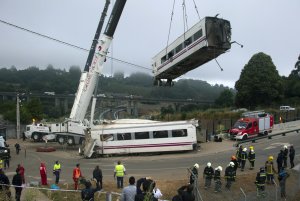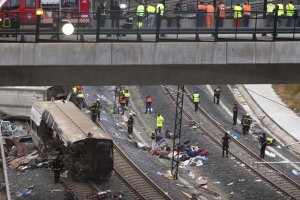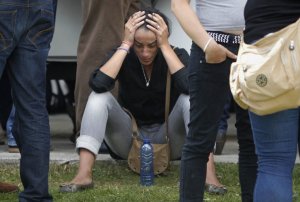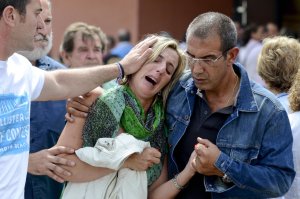ANTIAGO DE COMPOSTELA, Spain (AP) — By all accounts, the train was going way too fast as it curled around a gentle bend. Then in an instant, one car tumbled off the track, followed by the rest of the locomotive, which seemed to come apart like a zipper being pulled.
The derailment sent pieces of the sleek train plowing across the ground in a ghastly jumble of smashed metal, dirt and smoke.
But two days after Spain suffered its deadliest rail disaster in decades — which killed 80 people and maimed scores of others — one question surpassed all others: Why was the train moving so fast?
An American passenger on the train told The Associated Press he saw a monitor screen inside his car clocking the speed at 194 kph (121 mph) just before the crash — more than double the 80 kph (50 mph) speed limit on the curve where it derailed.
Investigators opened a probe Thursday into possible failings by the 52-year-old driver and the train's internal speed-regulation systems.
Experts said one, or both, must be at fault for the disastrous Wednesday night crash of the train that was carrying 218 passengers and five crew members to Santiago de Compostela, a destination of Catholic pilgrimage preparing to celebrate its most revered saint.
Instead, this stunned city of nearly 100,000 converted its sports arena into a shelter for the dead and the grieving.
"All Spaniards feel the pain of the families," said Spain's head of state, King Juan Carlos, as he and Queen Sofia met hospitalized survivors of the crash 2.5 miles (4 kilometers) south of Santiago de Compostela. The royal couple dressed in funereal black.
"For a native of Santiago like me, this is the saddest day," said Prime Minister Mariano Rajoy, who toured the crash scene and declared a national three-day mourning period.
The regional government of Galicia, in northwest Spain, said 94 people remained hospitalized, 31 of them in critical condition, including four children. The U.S. State Department said one American died and at least five others were hurt but cautioned that those figures could be revised upward.
The American victim was identified by the Diocese of Arlington as Ana Maria Cordoba, an administrative employee from northern Virginia. She and her husband and daughter were traveling to visit her son, who had completed the pilgrimage to Santiago de Compostela, according to Catholic News Service, a division of the U.S. Conference of Catholic Bishops.
Passenger Stephen Ward, an 18-year-old Mormon missionary from Utah, recalled seeing the 194 kph speed of the train when he looked up at the monitor showing it, then seconds later "the train lifted up up off the track. It was like a roller coaster."
He blacked out on impact and when he woke up, someone was helping him walk out of his train car and crawl out of a ditch where the train car came to rest. He thought he was dreaming for 30 seconds until he felt his blood-drenched face and noticed the scene around him.
"Everyone was covered in blood. There was smoke coming up off the train," he said. "There was a lot of crying, a lot of screaming."
Many victims suffered severe burns as the train's diesel fuel ignited a fire that caught some passengers trapped in mangled upside-down carriages. Emergency officials took DNA samples from the most heavily burned or the unconscious in an effort to identify both the living and the dead.
Rafael Catala, a senior transport official in Spain's Development Ministry, told radio network Cadena SER that the train appeared to be going much faster than the track's speed limit as it approached the city.
Breathtaking footage of the crash captured by a railway security camera showed the moment when the eight-carriage train approached a left bend beneath a road bridge at a seemingly impossible speed. An Associated Press analysis of the video indicated the train hit the bend going twice the speed limit or more.
Using the time stamp of the video and the estimated distance between two pylons, the AP calculated that the train was moving in a range of 144 to 192 kph (89 to 119 mph). Another estimate calculated on the basis of the typical distance between railroad ties indicated its speed was between 156 kph and 182 kph (96 to 112 mph).
The anonymously posted video footage, which the Spanish railway authority Adif said probably came from one of its cameras, shows the train carriages buckling and leaving the tracks soon into the turn.
Murray Hughes, consultant editor of Railway Gazette International, said a diesel-powered unit behind the lead locomotive appeared to derail first. The front engine quickly followed, violently tipping on to its right side as it crashed into a concrete wall and bulldozed along the ground.
In the background, the rear carriages could be seen starting to decouple and coming off the tracks. The picture went blank as the engine appeared to crash directly into the camera.
After impact, witnesses said, a fire engulfed passengers trapped in at least one carriage.
"I saw the train coming out of the bend at great speed and then there was a big noise," eyewitness Consuelo Domingues, who lives beside the train line, told The Associated Press. "Then everybody tried to get out of the train."
Other witnesses said nearby residents ran onto the tracks and worked to free survivors from the crumpled, flaming wreckage. Some were seen pounding rocks against windows, and one man wielded a pickaxe as survivors were pulled through shattered windows to safety.
Many aboard the train were Catholic pilgrims heading for Santiago de Compostela's internationally celebrated annual festival honoring St. James, a disciple of Jesus whose remains are said to rest in a church shrine. Since the Middle Ages, the city has been the destination for Christian faithful walking the mountainous El Camino de Santiago trail, or "The Way of St. James."
Santiago officials canceled Thursday's festivities and took control of the city's indoor basketball arena to use as a makeshift morgue. There, relatives of the dead could be seen sobbing and embracing each other.
The Interior Ministry ruled out terrorism as a cause.
While sections of the Spanish press pointed an accusatory finger at the train driver, government officials and railway experts cautioned that a fault in systems designed to keep trains at safe speeds could be to blame.
Jose Antonio Santamera, president of Spain's College of Civil Engineering, said one of the train's supposedly fail-safe mechanisms could have failed.
"The security system will detect any fault of the driver, (for example) if he has suffered a blackout and does not answer calls, and then starts the train's security systems. So I almost rule out human error," Santamera said.
He said the crash happened at a point where one speed-regulating system gave way to another, suggesting a possible failure at the handover point.
Spain's lead investigator in the crash, Judge Vazquez Tain, ordered detectives to question the train driver.
Train company Renfe identified the driver, Francisco Jose Garzon Amo, as a 30-year employee of the state rail company who became an assistant driver in 2000 and a fully qualified driver in 2003. The company said Amo took control of the train from a second driver about 100 kilometers (65 miles) south of Santiago de Compostela.
Renfe's president, Julio Gomez-Pomar Rodriguez, told Spain's Cadena Cope radio network that the driver had worked on that route for more than one year.
It was Spain's deadliest train accident since 1972, when a train collided with a stationary carriage in southwest Spain, killing 86 people and injuring 112.
"July 24 will no longer be the eve of a day of celebration but rather one commemorating one of the saddest days in the history of Galicia," said Alberto Nunez Feijoo, regional president of Galicia. Santiago de Compostela is its capital.
Passenger Sergio Prego told Cadena Ser the train "traveled very fast" just before it derailed and the cars flipped upside down, on their sides and into the air.
"I've been very lucky because I'm one of the few able to walk out," Prego said.
The Alvia 730 series train started from Madrid and was scheduled to end its journey at El Ferrol, about 95 kilometers (60 miles) north of Santiago de Compostela. Alvia operates high-speed services, but they do not go as fast as Spain's fastest bullet trains, called AVEs.
The maximum Alvia speed is 250 kph (155 mph) on tracks made especially for the AVEs, and they travel at a maximum speed of 220 kph (137 mph) on normal-gauge rails.
Other Spanish train calamities include a 1944 accident involving three trains that crashed in a tunnel. That disaster produced wildly disputed death tolls ranging from the government's official count of 78 to researchers' later estimated tolls exceeding 500.
In 2006, 43 people died when a subway train crashed because of excessive speed in the southern city of Valencia.
In 2004, 191 died when al-Qaida-inspired terrorists detonated 10 bombs on four Madrid commuter trains.
___
Online: http://www.youtube.com/watch?v=5ywaI50egqk
___
Associated Press writers Alan Clendenning, Ciaran Giles and Harold Heckle in Madrid, Panagiotis Mouzakis, Fisnik Abrashi and Robert Barr in London, Deb Riechmann in Washington, Brady McCombs in Salt Lake City and Shawn Pogatchnik in Dublin contributed to this report.





